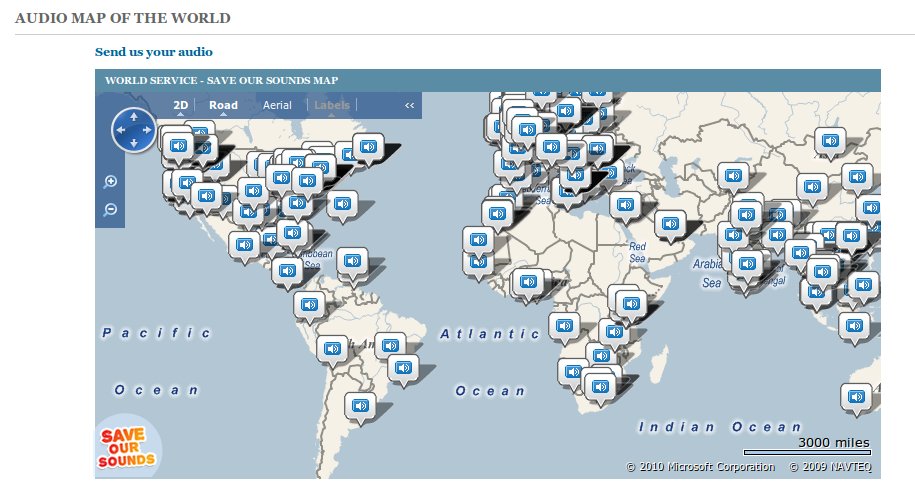The sound is really produced by the coils. To play an A at 440 Hz the coil generate 440 lightnings per second. The temperature of the lightning is so high that compress the air around generating an audio wave.
Category Archives: Audio
Space Audio
A good site of “sounds of space” collected by U Iowa instruments on various spacecraft.
Here you can find many sounds “recorded” (remember that this are radio frequencies not audio frequencies) by Cassini, Voyagers and Galileo spacecrafts during the Jupiter and Saturn missions.
The site is Space Audio.
Here you can listen to the famous Cassini’s sound recorded near Saturn claimed to resemble to an alien voice if transposed one octave up preserving the duration:
Bloop
The Bloop is the name given to an ultra-low frequency and extremely powerful underwater sound detected by the U.S. National Oceanic and Atmospheric Administration (NOAA) several times during the summer of 1997. The source of the sound remains unknown.
According to thw NOAA description
it rises rapidly in frequency over about one minute and was of sufficient amplitude to be heard on multiple sensors, at a range of over 5,000 km.
5000 km is a grrreeeat distance for a sound, event in the water that conduct the sounds better than air. While the audio profile of the bloop does resemble that of a living creature, the system identified it as unknown because it was far too loud for that to have been the case: it was several times louder than the loudest known biological sound.
By 2012, earlier speculation that the sound originated from a marine animal was replaced by NOAA’s description of the sound as being consistent with noises generated via non-tectonic cryoseisms originating from glacial movements such as ice calving, or through seabed gouging by ice.
The bloop sound it’s too low to be perceived by a human ear. If transposed up by a factor of 8 (3 octaves), it sounds like this.
The Power of the Slinkies
 For italian people:
For italian people:
Slinky è il nome commerciale di questo giocattolo, formato da una lunga molla elicoidale, in voga (boh) forse 20-30 anni fa (è stato inventato negli anni ’40; io ne ho almeno 4/5, ma non ricordo quando le ho comprate).
Vedi anche wikipedia.
A sound wave in a long wire travels back and forth and produces an echo effect. This fact was well known to the old sound engineers and the so called spring reverberator was largely used in the analogical era.
In this video micolich shows the power of long springs. When touched, the sound travels repeatedly along the whole length of the spring producing a stream of little echoes with decreasing amplitude. But the sound speed is high, so the time distance between echoes is a question of milliseconds. As result we can’t perceive the single echo, but a decreasing halo that extend the sound: this is the reverberation.
Electromagnetic sounds from planets
Another fascinating recording of space sounds captured by a NASA spacecraft.
This time it’s Jupiter sounds (electromagnetic “voices”) recorded by the Voyager. The complex interactions of charged electromagnetic particles from the solar wind , planetary magnetosphere etc. create vibration “soundscapes”.
Jupiter is mostly composed of hydrogen and helium. The entire planet is made of gas, with no solid surface under the atmosphere. The pressures and temperatures deep in Jupiter are so high that gases form a gradual transition into liquids which are gradually compressed into a metallic “plasma” in which the molecules have been stripped of their outer electrons. The winds of Jupiter are a thousand metres per second relative to the rotating interior. Jupiter’s magnetic field is four thousand times stronger than Earth’s, and is tipped by 11° degrees of axis spin. This causes the magnetic field to wobble, which has a profound effect on trapped electronically charged particles. This plasma of charged particles is accelerated beyond the magnetosphere of Jupiter to speeds of tens of thousands of kilometres per second. It is these magnetic particle vibrations which generate some of the sound you hear on this recording.
It’s interesting to compare this recording with some analog electronic music from the sixties (cfr. Screen (1968) by Jaap Vink) or some orchestral compositions by Gyorgy Ligeti (Lontano (1967) or Atmosphère).
In addition should be interesting to know if and how this recordings had been edited by the people of Brain/Mind Research that sell many NASA recordings.
Here are similar recordings from Uranus…
… and Neptune.
Animals sound perception: elephants
An interesting table showing the hearing ranges for some animals [from Animal Behavior Online]
| domestic cats | 100-32000 Hz |
| domestic dogs | 40-46000 Hz |
| African elephants | 16-12000 Hz |
| bats | 1000-150000 Hz |
| rodents | 70-150000 Hz |
I am impressed by the incredible hearing range of the rodents.
The infrasonic communications of the elephants is well known. African elephants have a social structure best described as fluid; animals move freely over wide areas, sometimes affiliating with other animals. Female members of a family tend to stay together, and of course their juveniles travel with them. These female-centered groups may merge with other such groups periodically. Adult males are less likely to join groups.
Female African elephants use “contact calls” to communicate with other elephants in their bands (usually a family group). These infrasonic calls, with a frequency of about 21 Hz and a normal duration of 4-5 seconds, carry for long distances (several kilometers), and help elephants to determine the location of other individuals. Calls vary among individual elephants, so that others respond differently to familiar calls than to unfamiliar calls. Perhaps elephants can recognize the identity of the caller.
Perception of infrasounds, however, presents some specific problems. An object smaller than the distance between waves is a poor receiver for those waves. Thus infrasonic receivers need to be large. This is probably the reason that infrasonic communication is used by only a few animals, and the best understood infrasonic communication system is the African elephant’s.
The large pinnae (external portion of the ear; trad.: il padiglione auricolare) in the African elephant may play an important role in the elephant’s perception of low frequency sounds, which are significant in communication among elephants. Receiving structures whose size is matched to the wavelength of the sound perform better.
Save Our Sounds
In a radio programme called Save Our Sounds, the BBC asked their listeners to upload sound recordings from where they live in order to create an audio map of the world.
Here is the call:
Help to create a snapshot of the world in sound!
We’re really excited about Save Our Sounds, but we need your help to create an audio map of the world. We’re especially keen to preserve endangered sounds for future generations.
You can get involved by sending us sounds from where you live, and then listen your way around the world with our interactive map.
Please upload your sounds onto our map.
Find out more about Save Our Sounds and follow our recording tips in order to collect the best quality sound.
So get recording and take us all on a journey through sound!
In this page you can listen to audio fragments from the whole world.

Music for cats
 This site claims to produce “authentic cat music based on feline communication and hearing.”
This site claims to produce “authentic cat music based on feline communication and hearing.”
When I was a student, there was cats on my house. I remember that, when listening to music, sometimes I observed their behavior and try to imagine their perception of the sounds and the meaning of the music for them.
I also remember that sometimes they moved a paw in front of the speaker. Not on the speaker, but in front of it, about half meter distant (speakers was on the floor), like trying to touch something.
Now I have no cats, so I can’t test it. But if someone could try and refer, it should be interesting. The songs are written in three different styles – each song style is designed to convey and evoke a particular mood.
Listen to samples from the main page
The DFW Audio Project
…it’s a series of audio recordings by David Foster Wallace, the author of Infinite Jest, which Time included in its All-Time 100 Greatest Novels list.
The collection is here and is broken into four categories:
Gelie
An interesting application for iPhone that links sound and gestures. The sound needs some improvements but the idea is stimulating.
